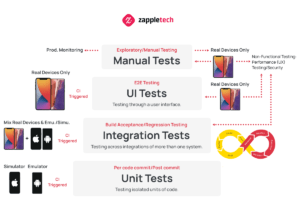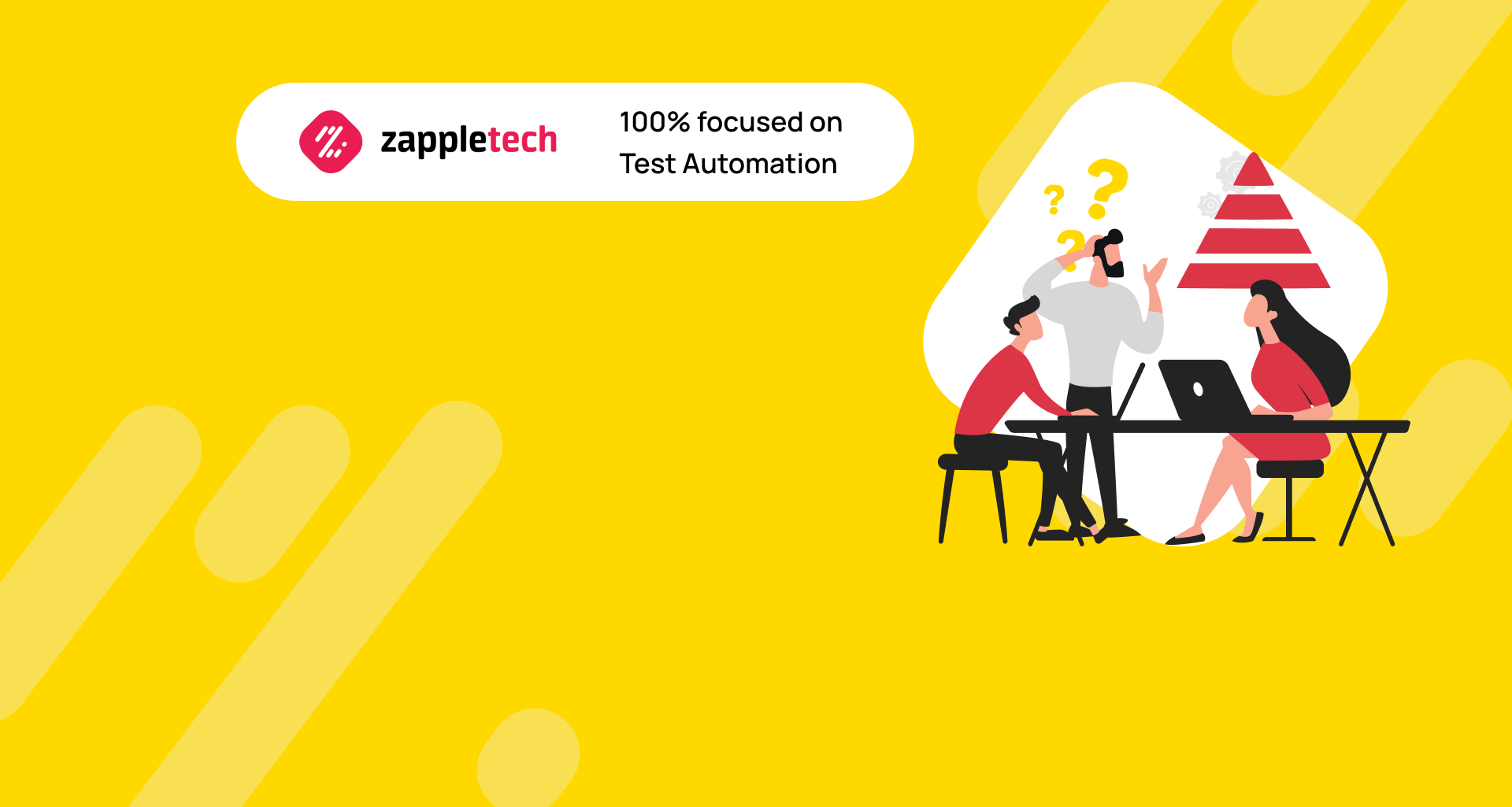Can we overestimate the importance of automation testing, especially if we strive to develop a genuinely high-quality product? The answer is no. Automation testing plays a crucial role in ensuring software quality, but it’s also vital to recognize the associated risks in software testing. Therefore, an equally important issue is optimizing this process and its structure to mitigate those risks.
To address these challenges, Mike Cohn proposed the concept of the test automation pyramid, which he described in his book Succeeding With Agile. This concept includes three categories of software tests—unit tests, service tests, and UI tests—that provide significant benefits in development. By emphasizing a strong foundation of unit tests and fewer end-to-end tests, the pyramid helps teams achieve faster feedback loops, reduce maintenance costs, and minimize the risks in software testing that can arise from over-reliance on brittle UI tests.
Thanks to the software testing pyramid, developers began producing higher quality IT products with less energy and time consumption. However, while the pyramid offers a structured approach to test automation, it’s essential to remember that it doesn’t eliminate all risks in software testing, such as the potential for overlooked edge cases or integration issues. This highlights the importance of a balanced testing strategy that includes both automated and manual tests.
But is this statement enough to describe the whole concept? Let’s delve deeper into the details of the pyramid testing concept to understand its full impact and how it addresses the inherent risks in software testing!
The test automation pyramid emphasizes building a large base of unit tests because they are fast, reliable, and easy to maintain. Focus on covering individual components and functions to catch bugs early in the development process.Mykhailo PoliarushCEO, ZappleTech Inc.
Table of Contents
Introduction to Test Automation Pyramid
The test automation pyramid is a crucial concept in software testing that provides a structured approach to creating high-quality software. It emphasizes the importance of categorizing tests into different levels to achieve a balanced and efficient testing process. This framework is designed to help developers and QA teams optimize their test suites, ensuring comprehensive coverage while minimizing the time spent on testing and bug detection.
At its core, the test automation pyramid is a metaphor that organizes software tests into three primary levels: unit tests, integration tests, and end-to-end tests. Each level plays a distinct role in the testing process, and the pyramid visually represents the ideal distribution of these tests. The base of the pyramid, which is the widest part, is composed of unit tests. These tests are the most numerous because they are fast, easy to maintain, and provide immediate feedback on individual components of the code.
Moving up the pyramid, integration tests are fewer in number compared to unit tests. They test the interaction between different modules or services, ensuring that they work together as expected. Although integration tests take longer to run and are slightly more complex to set up, they are crucial for verifying the behavior of interconnected components.
At the top of the pyramid, there are the end-to-end tests, which are the least in number. These tests simulate real user scenarios and validate the entire application flow from start to finish. While end-to-end tests are valuable for confirming that the system works as intended, they are slower and more prone to failures due to their complexity and the need for a fully integrated environment.
By following the principles of the test automation pyramid, teams can create a balanced and effective test strategy that prioritizes faster, more reliable tests at the base and gradually includes more complex, higher-level tests. This approach not only helps in maintaining a quality test suite but also reduces overall testing time and effort, leading to more efficient software development cycles.
Mike Cohn’s original test pyramid consists of three levels (from bottom to top):
- Unit tests.
- Integration tests
- User interface (UI/exploratory) tests.
There are also opinions that this concept is insufficient. Someone even claims that these aspects are unfinished, making the test automation pyramid seem oversimplified.
For instance, the test automation pyramid has not even three but five main levels. So, end-to-end testing and Exploratory / Manual Tests are also added to the top branch. But it all covers the same top level.
Three Levels of Test Automation Pyramid Concept

If we consider in detail, we are talking about three basic levels of the pyramid, commonly referred to as the “test automation pyramid.” This model emphasizes a layered approach to testing, where the base consists of a large number of automated tests, primarily unit tests. These tests are quick to execute, cost-effective, and provide fast feedback on the most critical parts of the application—the code.
The middle layer of the pyramid typically includes service or API tests. These tests are less numerous than unit tests but are still automated. They validate the interactions between different components and services, ensuring that integrations work as expected. These tests are crucial because they help catch issues that unit tests might miss while still being faster and more reliable than UI tests.
At the top of the test automation pyramid is the UI testing level, where the least number of tests are performed. These tests often involve manual testing or scripted automated tests that mimic user interactions with the application. Since these tests are more complex, time-consuming, and prone to flakiness, they are minimized to avoid slowing down the development cycle. The pyramid’s structure, therefore, follows a pattern: the higher the level, the fewer tests are executed, underscoring the importance of balancing the types and quantity of tests to maintain an efficient and robust testing strategy.
The Base Level of the Pyramid Testing: Unit Tests
These tests are small and should ensure that isolated blocks of code work properly. They test only one variable without relying on any additional ones. What benefits and features hides this software testing pyramid level:
- Automation tasks are not closed until these scripts are run on the implemented functionality.
- They are developing simultaneously as unit tests force developers to think about the problem they are solving and any edge cases they
- may encounter.
- The tests are detailed and can help pinpoint the defect.
- Run times are incredibly fast because they don’t have to rely on any user interface or external systems like a database or API.
- They are inexpensive, easy to write, easy to maintain.
Unit tests are best used for devices on simulators and emulators (virtual devices). It provides the feedback you need, detailed reports, and simple fast and time-saving testing.
The Middle Level: Integration Tests
The first difference between these tests and modular ones is that CI runs them. They also involve the integration of more than one system. So, you have more features and different types of testing to cover manually:
- Developers use this layer to test business logic without using the user interface (UI);
- By testing outside of the user interface, you can test the inputs and outputs of APIs or services without all the complexity that the user interface introduces;
- These tests are slower and more complex than unit tests because they may need to access the database or other components.
This type of testing involves both real and virtual devices, depending on the type of testing. For example, performance testing or security testing is only possible for real devices, as they need to evaluate the software’s behavior under real-world conditions. On the other hand, acceptance testing is possible for virtual instruments, providing a more controlled environment that can help in replicating specific scenarios.
To create a high-quality testing process, it’s essential to strike a balance between real and virtual devices. This approach aligns with the principles of the test automation pyramid, which emphasizes the importance of having a solid foundation of automated tests at various levels. By combining real and virtual devices, you ensure that each layer of testing — from unit tests at the base of the pyramid to end-to-end tests at the top — is executed effectively. This strategy helps optimize the testing workflow, reduces costs, and increases the overall efficiency of your builds and tests, ultimately leading to a more reliable and robust software product.
While unit tests cover individual pieces, integration tests ensure these pieces work well together. Keep the number of integration tests moderate to maintain speed and efficiency while verifying that different components interact correctly.Sergey AlmyashevCOO, ZappleTech Inc.
The Top Level: User Interface Tests
This category in the QA testing pyramid includes user exploratory testing and user interface testing. It also means that they are performed manually and take more time, but they involve a much smaller number of tests according to the pattern. So, to summarize this level, we can say the following:
- User interface tests should be placed at the top of the pyramid.
- Most of your code and business logic should already be tested to this level;
- Interface tests are written to make sure that the interface itself works correctly;
- UI tests are slower and harder to write and maintain, so you need to keep them to a minimum.
The top of the pyramid of testing also assumes only real devices, not virtual ones. This approach is critical for end-to-end and exploratory testing because it better simulates real users’ devices and helps detect defects that can occur under various circumstances, such as application conflicts, network problems, or other unexpected issues. Incorporating real devices aligns with the principles of the test automation pyramid, emphasizing the importance of testing in environments that closely resemble real-world conditions. This strategy ensures that the final product functions as intended across different scenarios, providing a more reliable and robust user experience.
Inverted Testing Pyramid or Ice Cream Cone
The inverted pyramid is considered not recommended, although this approach is found in practice. There’s no surprise that this concept isn’t popular:
- UI tests should be more automated.
- Long test runs. Runtime takes much longer than other types of tests because it relies on interacting with visual UI elements and doesn’t necessarily have hooks in the source code;
- Difficult to maintain, as user interface tests are difficult to write and very dependent on even the slightest changes;
- More suitable for positive path scenarios. Testing negative paths in end-to-end tests is very costly and time-consuming compared to lower-level tests;
- Waiting to write unit tests until features are complete can result in everyone doing a lot of work multiple times to solve a problem.
It’s more like an anti-pattern that some use to visualize test ratios in end-to-end testing.
What Structure Have These Test Categories
- Experienced developers offer a convenient algorithm for working with unit tests (and not only).
- Setting up test data.
- Calling the method under test.
- Verify that expected results are returned.
There is a good mnemonic for remembering this structure, as the principle of three A’s stands for Arrange, Act, and Assert. This simple approach helps testers organize their test cases in a clear and structured manner, ensuring that the setup, execution, and verification stages are clearly defined. Other mnemonics rooted in Behavior-Based Development (BDD), such as Given-When-Then, may also be used to enhance the clarity and focus of tests, especially in scenarios that demand more descriptive or narrative-based specifications.
This pattern can be applied to other higher-level tests as well, including integration and end-to-end tests, which are crucial components of the test automation pyramid. The test automation pyramid emphasizes the importance of a solid foundation of unit tests, a moderate number of integration tests, and fewer UI tests to ensure a balanced and efficient testing strategy. By using these structured approaches, teams can effectively manage the complexity of their test suites and maintain high-quality code standards.
5 Tips About Testing Pyramid
It is worth noting that the testing pyramid in DevOps is a reliable and practical system. It will speed up your work, contribute to developing a quality product, and avoid many mistakes. Unless, of course, remember a couple of main principles:
- Write tests with different details.
- The higher the level, the less testing.
- Stick to the shape of a pyramid to create a robust, fast, and user-friendly test suite.
- Write small and fast unit tests.
- Write some more general tests.
- And there are very few high-level end-to-end tests that test the application from start to finish.
Also, try to avoid test duplication and ensure that the higher-level test focuses on the part that the lower-level tests cannot cover.
In each case, they ensure that the tests remain light and readable. Also, tests written with this structure tend to be shorter and more expressive.
Final Words
The test automation pyramid streamlines all testing processes by dividing them into three (or sometimes five) distinct categories, offering a structured and efficient approach to software testing. This framework emphasizes effective time management, giving testers a proven blueprint for organizing their projects. By categorizing tests into levels based on their purpose and execution, the pyramid allows teams to focus on building a strong foundation of unit tests while incorporating higher-level tests, such as integration and end-to-end tests, as needed.
At the base of the pyramid is unit testing, which is fully automated and typically executed on virtual devices, providing a fast and reliable way to catch bugs early in the development process. As you move up the pyramid, integration and UI tests come into play, requiring fewer tests but often conducted on real devices to ensure that all components work seamlessly together. The top level, often involving manual testing, focuses on the fewest tests but targets critical paths that must function correctly in real-world scenarios.
Implementing the test automation pyramid can significantly boost your team’s productivity by optimizing the testing strategy and offloading repetitive tasks. To leverage this approach effectively, it’s crucial to write the tests correctly or consider entrusting this task to professionals who specialize in automation.
UI tests sit at the top of the test automation pyramid, and because they are slower and more prone to breaking, you should use them sparingly. Focus on critical user flows and high-risk areas to ensure that the user experience is smooth and functional without overloading your test suite.Mikhail BodnarchukCDO, ZappleTech Inc.
At Zappletech, we specialize in all aspects of automation testing. With over 40 completed test automation and infrastructure projects spanning six years, we continuously improve our services to provide clear, reliable results without delays. Our team is dedicated to delivering high-quality software and giving you the confidence you need in your product’s performance and reliability.







